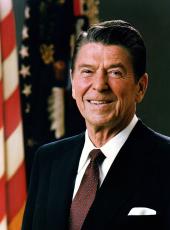
Remarks at a White House Ceremony Marking the Golden Anniversary Year of the Duck Stamp
The President. Secretary Clark and ladies and gentlemen, good morning, and welcome to the White House.
Today we join in honoring the 50th anniversary of one of the most successful and popular of all Federal wildlife conservation programs. Officially, the centerpiece of this program is called the Migratory Bird Hunting and Conservation Stamp, but to wildlife lovers across the country, it's known as the Duck Stamp.
The Duck Stamp was the brainchild of a famous Iowan and a great American, the award-winning editorial cartoonist and conservationist, J.N. Darling, known to all as "Ding." Ding was one of the foremost conservation figures of his day. And throughout his career as a cartoonist, that commitment to conservation came through loud and clear.
Sometimes Ding drew a bleak picture; but he did so for a purpose, to shake his fellow citizens out of their complacency about our resources. Too many still considered our resources inexhaustible, and Ding knew different. For millions of Americans, he made the concept of conservation come alive.
Ding saw the greed and the foibles that threatened to wreck our resources. But he also saw the abiding goodness of one very important species, his fellow man. Ding was convinced that Americans would respond to the call for help for our wildlife and that efforts could reverse the serious decline that was affecting our wildlife and waterfowl. And he was right on both counts. The people responded, and the waterfowl came back.
More than anything else, it was Ding's idea for a Duck Stamp that enabled the change to take place. The Duck Stamp quickly caught on with duck hunters, corporations, and conservation groups of all kinds. To date, nearly 89 million stamps have been sold for revenues totaling nearly $300 million. And those revenues have been used to purchase thousands of acres of wetlands. One hundred and eighty-six of our National Wildlife Refuges have been funded wholly, or in part, through the Duck Stamp program.
These refuges serve as a haven for waterfowl, protect fish and other wildlife, reduce flooding, and serve as natural water purifiers. For five decades, you, the sportsmen and conservationists, have been buying Duck Stamps and have been giving our nation a gift of beautiful wetlands and flourishing wildlife.
On behalf of all Americans, I thank you. And as Duck Stamps begin their second half-century, I believe we can expect to see more and more Americans join in your tradition of giving. So, thank you, God bless you, and now I'd like to sign the resolution proclaiming the week of July i through July 8, National Duck Stamp Week, and 1984 the Golden Anniversary Year of the Duck Stamp.
[At this point, the President signed SJ. Res. 270.]
Secretary Clark. Mr. President, I believe everyone here today shares your great appreciation for the Duck Stamp program, really America's finest and most successful conservation program, again bridging—as I know you've always desired to do—the private and public sectors.
And we're fortunate today to have the grandson of Mr. Darling, and Kip Koss, who is with us today to make a presentation. And Kip has followed the inspiration of his grandfather, dedicating his life to conservation. And at this time, Kip would like to make a little presentation.
Mr. Koss. Mr. President, 50 years ago, Ding Darling designed the first Federal Duck Stamp. It's been a marvelously successful program—3 1/2 million acres of prime wetland habitat have been preserved forever.
I have here today an original Darling etching. It's titled "Design for the First Federal Duck Stamp, 1934." And with it is an RW-1, which is the first Federal Duck Stamp issued in 1934.
We conservationists here today—the Ding Darling Foundation, Izaak Walton League, Ducks Unlimited, National Wildlife Federation-we're all pleased to present this to you.
The President. Thank you very much. I think I should explain, I'm not crying. The tears are in my eyes because Bill Clark managed to aim this at the Sun, right in my eyes just as I turned around.
Thank you very much.
Reporter. Why did you name Anne Burford to that commission, Mr. President?
The President. I haven't any comment other than that, that I think she deserves some consideration. And we're very pleased to give it and to have her back in the administration.
Q. Mr. President, Jay Hair, who organized this—
Q. The environmentalists say you should be ashamed of yourself, sir.
Q.—didn't show up in protest because of the Burford appointment. What do you have to say to that?
The President. Haven't been to lunch yet. Maybe he'll be there.
Q. He's going to hold a press conference and denounce that appointment.
Note: The President spoke at 11:32 a.m. in the Rose Garden at the White House.
Secretary of the Interior William P. Clark also made remarks.
Ronald Reagan, Remarks at a White House Ceremony Marking the Golden Anniversary Year of the Duck Stamp Online by Gerhard Peters and John T. Woolley, The American Presidency Project https://www.presidency.ucsb.edu/node/261127

